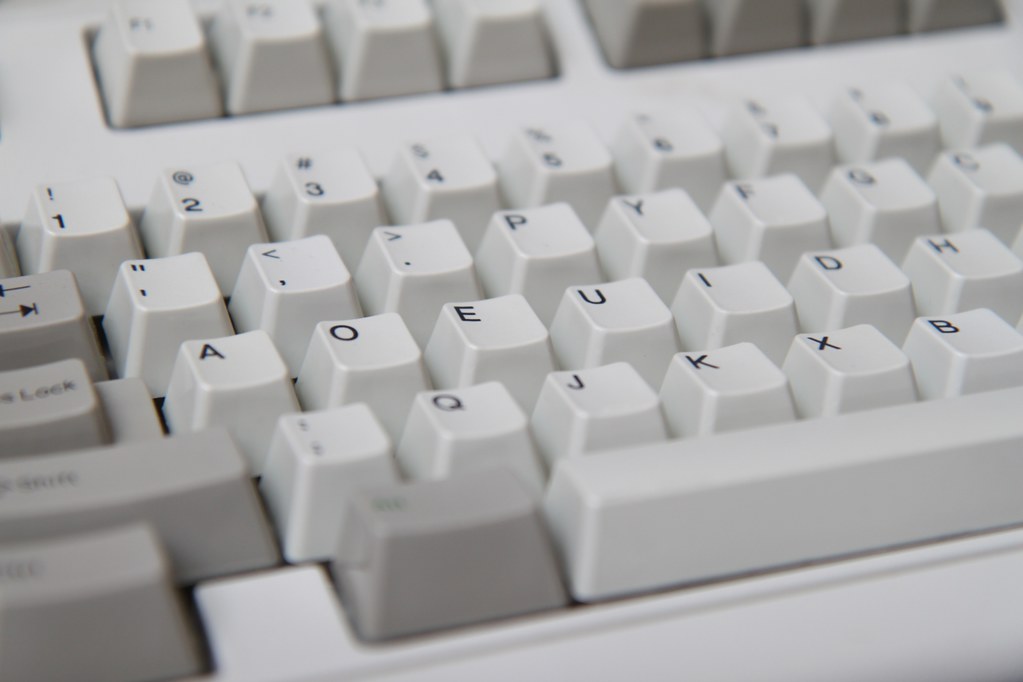In the world of typing and keyboard layouts, few topics stir as much debate as the Dvorak Simplified Keyboard. Patented in 1936 by August Dvorak and his brother-in-law, William Dealey, the Dvorak keyboard was born out of a desire to optimize the typing experience. The standard QWERTY layout, which had been the de facto choice for over six decades, was believed by Dvorak to be inefficient and a contributor to typing errors and fatigue.
The Dvorak layout was meticulously engineered to address the perceived shortcomings of QWERTY. It was designed to minimize finger motion, reduce errors, and potentially increase typing speed. The layout strategically placed the most commonly used letters and bigrams on the home row, where fingers naturally rest, and distributed the typing load more evenly between both hands. This was a stark contrast to QWERTY, where typing is predominantly done with the left hand and often involves awkward finger motions and jumping over the home row for common letter combinations.
Dvorak’s principles were clear: alternate hand use for a more rhythmic typing experience, position the most frequently used letters under the strongest fingers, relegate the least common letters to the bottom row, and ensure the right hand does more work, given that most people are right-handed. These principles were underpinned by Dvorak’s research into letter frequencies, bigrams, and the physiology of the hand.
Despite the thoughtful design, the Dvorak layout has not supplanted QWERTY as the standard. The reasons often cited include QWERTY’s entrenched position due to its earlier introduction and the debated, relatively small advantages of Dvorak. However, modern operating systems offer users the choice to switch to the Dvorak layout, demonstrating its continued relevance.
The original Dvorak layout has undergone several modifications over the years, leading to variations known as the Dvorak Simplified Keyboard or the American Simplified Keyboard. These variations, while different in some respects, still adhere to the core principles set out by Dvorak and Dealey.
The history of the Dvorak keyboard
The history of the Dvorak keyboard is intertwined with August Dvorak’s career as an educational psychologist and professor. His journey into keyboard design began while advising a student’s thesis on typing errors, which led him to conclude that QWERTY was flawed. Alongside Dealey, Dvorak embarked on extensive research to create a superior layout. Their efforts culminated in the Dvorak Simplified Keyboard, which they believed would revolutionize typing.
Dvorak’s efforts to promote his layout included entering typists trained on it into typing contests and conducting an experimental program in a Tacoma school district. The results seemed promising, with students learning Dvorak in a fraction of the time it took to learn QWERTY. However, the program was eventually terminated by a new school board.
The most significant challenge to the Dvorak layout came from a study conducted by the General Services Administration led by Earle Strong. The study, which involved retraining typists from QWERTY to Dvorak and vice versa, failed to show a clear advantage for the Dvorak layout. Strong’s study, however, was not without controversy, as he had a known bias against new keyboard designs.
Despite the setbacks, the Dvorak keyboard has had a lasting impact, paving the way for other optimized layouts and adaptations for different languages. Its principles have influenced layouts like Colemak, German Neo, and French BÉPO, demonstrating the potential for alternative keyboard designs to enhance typing efficiency.

The original Dvorak layout has seen various symbol keys shift around over the decades, leading to the standardized ANSI Dvorak layout. This layout, while different from Dvorak’s initial design, still offers the benefits of his ergonomic principles. The Dvorak layout’s availability across major operating systems and devices, including PCs and smartphones, attests to its enduring presence in the world of keyboard layouts.
The journey of the Dvorak keyboard layout is a fascinating tale of innovation, research, and the challenges of changing established norms. Despite the initial promise and the backing of its creator’s extensive studies, the Dvorak layout has faced an uphill battle in its quest to dethrone the entrenched QWERTY standard. The narrative of the Dvorak keyboard is not just about the layout itself, but also about the human factors that influence the adoption of new technologies.
One of the most pivotal moments in the history of the Dvorak keyboard was the Navy study conducted by August Dvorak himself. This study is often cited by proponents of the Dvorak layout as evidence of its superiority. Dvorak’s research claimed that typists could be retrained to his layout in a mere 10 days, a fraction of the time it would take to master QWERTY. However, the study’s validity has been questioned due to potential biases, as Dvorak owned the patent on the keyboard layout he was promoting. This conflict of interest has cast a shadow over the study’s findings and has been a point of contention in discussions about the layout’s efficacy.
Despite the controversy surrounding the Navy study, the Dvorak layout has garnered a dedicated following. The layout’s design principles, such as reducing finger motion, alternating hand use, and placing the most common letters under the strongest fingers, resonate with many users. These principles are aimed at creating a more comfortable and efficient typing experience, which has led some to switch from QWERTY to Dvorak.
The modern computing era has seen a resurgence of interest in alternative keyboard layouts, and the Dvorak layout has benefited from this trend. Major operating systems, including Windows, macOS, Linux, and various distributions of BSD, offer the Dvorak layout as an option for users. This accessibility has allowed those curious about the layout to try it without the need for specialized hardware. The advent of smartphones and tablets has further expanded the reach of the Dvorak layout, with iOS and Android providing support for it.
The Dvorak layout’s influence extends beyond its own keys
It has paved the way for other optimized layouts such as Colemak, as well as adaptations for different languages like German Neo and French BÉPO. These layouts have taken the principles established by Dvorak and applied them to the unique linguistic needs of other languages, demonstrating the versatility and impact of Dvorak’s research.
Despite its availability and the passionate advocacy of its users, the Dvorak layout has not achieved widespread adoption. The reasons for this are multifaceted. The QWERTY layout’s historical head start and the cost of retraining typists are significant barriers. Moreover, the benefits of the Dvorak layout, while appealing in theory, have not been conclusively proven to be substantial in practice. Studies have shown that other keyboard layouts can yield similar typing speeds to both QWERTY and Dvorak when typists are adequately trained, suggesting that the layout may be just one factor in typing efficiency.
The Dvorak keyboard’s journey is a testament to the complexity of human-machine interaction and the inertia of established standards. While it may not have revolutionized the world of typing as its creator hoped, the Dvorak layout remains a noteworthy chapter in the history of keyboard design. Its principles continue to inspire and challenge our conceptions of what makes for efficient and ergonomic typing, ensuring that the conversation about keyboard layouts remains as dynamic and engaging as ever.
Related posts:
Dvorak keyboard layout
The Dvorak Keyboard Controversy
Perhaps August Dvorak Is More Your Type





